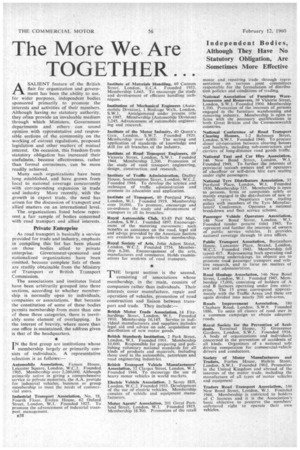The More We Are TOGETHER . .
Page 72

If you've noticed an error in this article please click here to report it so we can fix it.
SALIENT feature of the British flair for organization and govern ment has been the ability to use, for wider purposes, independent bodies sponsored primarily to promote the interests and activities of their members. Although having no statutory authority, they often provide an invaluable medium through which Ministers, Government departments and others can sound opinion with representative and responsible sections of the community on the working.of carrent regulations, proposed legislation and other matters of mutual interest. On occasion, this freedom from statutory obligation has increased their usefulness,because effectiveness, rather than formal correctness, can be more readily achieved.
Many such organizations have been long established, and have grown from local to national coverage concurrently with corresponding expansion in trade and industry More 'recently,. with the growth in export trade, the need has arisen for the discussion of transport and allied matters on an international level.
The organizations listed below represent .a fair sample of bodies concerned with road transport and allied interests.
Private Enterprise
As road transport is basically a service provided for trade and industry, emphasis in compiling this list has been placed on those bodies allied to private enterprise. Government-sponsored and nationalized organizations have been omitted, because complete lists of them are readily obtainable from the Ministry of Transport or British Transport Commission.
The associations and institutes listed have been arbitrarily grouped into three sections, according to whether membership is normally open to individuals, companies or associations. But because the constitution of some of these bodies permits membership from more than one of these three categories, there is inevitably some element of overlapping. In the interest of brevity, where more than one office is.maintained, the address given is that -of the headquarters.
I N the first group are institutions whose membership largely or primarily consists of individuals. A representative selection is as follows:— Automobile Association, Fannin House, Leicester Square, London, W.C.2. Founded 1905. Membership over 2,260,000. Although primarily active in giving a comprehensive service to private motorists, the A.A. provide for industrial vehicles, business or group membership to meet the needs of commercial users.
Industrial Transport Association, No. IS, Fourth Floor, Evelyn House, 62 Oxford Street, London, W.I. Founded 1927. To promote the advancement of industrial transport management.
n38 Institute of Materials Handling, 69 Cannon Street, London, E.C.4. Founded 1953. Membership 1,665. To encourage the study and development of efficient handling techniques.
Institution of Mechanical Engineers (Automobile Division), 1 Birdcage Walk, London, S.W.1. Amalgamated under present title in 1947. Membership (Automobile Division) 3,245. Advancement of automobile engineer ing and research. • Institute of the Motor Industry, 40 Queen's Gate, . London, S.W.7. Founded 1920. Membership over 6,000. The setting and application of Standards of knowledge and skill for all branches of the industry.
Institute of Road Transport Engineers, 69 Victoria Street, London, S.W.1. Founded 1944. Membership 2,200. Promotion of the study of road transport engineering, design, construction and research, Institute of Traffic Administration, Dudley Elouse, Southampton Street, London, W.C.2. Founded 1944. To develop the Science and technique of traffic administration and promote its education and application.
Institute of Transport, 80 Portland Place, London, W.I. Founded 19)9. Membership over 10,000.. To promote, encourage and co-ordinate the study and advancement of transport in all its branches.
Royal Automobile Club, 83-85 Pall Mall, London, S.W.I. Founded 1897. Encouragement of the motoring movement; such benefits as assistance on the road, legal aid and advice provided by the Associate Section are available to goods-vehicle membership.
Royal Society of Arts, John Adam Street, London, W.C.21 Founded 1754. Membership 6,200. Encouragement of the arts, manufactures and commerce. Holds examinations for students of road transport.
THElargest section is the second, consisting of associations whose membership, in the main, consists of companies rather than individuals. Their interests cover manufacture, repair and operation of vehicles, promotion of road construction and liaison between trans
port and trade. They include:—
British Motor Trade Association, 14 Fitzhardinge Street, London. W.I. Founded 1910. Membership 16,147. Service to individual manufacturers and suppliers includes legal aid and advice on sale, acquisition or distribution of new motor goods.
British Standards Institution' 2 Park Street, London, W.1. Founded 1901. Membership 10,600. Responsible for preparing and publishing voluntary national standards for all kinds of products and materials, including those used in the automobile, petroleum and road engineering industries.
British Transport Vehicle Manufacturers' Association, 32 Clarges Street, London, W.1. Founded 1944. To encourage the use of heavy motor vehicles in world markets.
Electric Vehicle Association, 2 Savoy Hill, London, W.C.2. Founded 1933. Development of the use of electric vehicles. Membership consists of vehicle and equipment manufacturers.
Motor Agents' Association, 201 Great Portland Street. London, W.1. Founded 1913. Membership 18,700. Promotion of the retail




















































































































